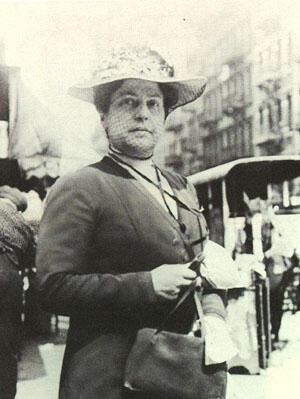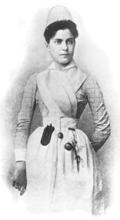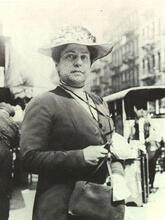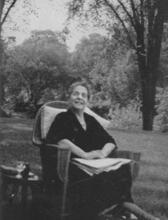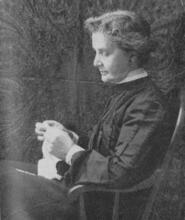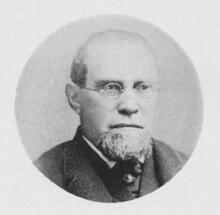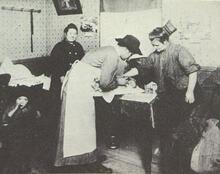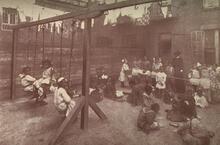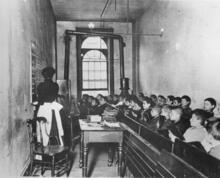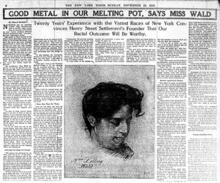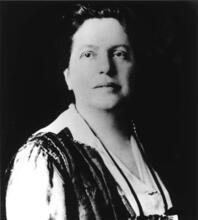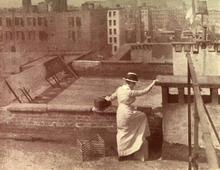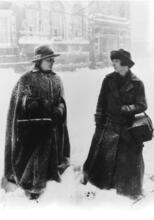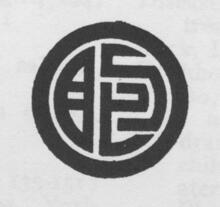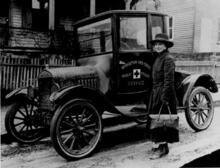Lillian Wald
Lillian D. Wald was a practical idealist who worked to create a more just society. Her goal was to ensure that women and children, immigrants and the poor, and members of all ethnic and religious groups would realize America's promise of "life, liberty and the pursuit of happiness."
As a young nurse, Wald hoped to provide decent health care to residents of New York's Lower East Side tenements. Her work as the founder of the Henry Street Settlement and the Visiting Nurse Service demonstrated her masterful administrative talents, deep regard for humanity and skill at fundraising and publicizing. Championing the causes of public health nursing, housing reform, suffrage, world peace, and the rights of women, children, immigrants and working people, Wald became an influential leader in city, state, and national politics. Her tireless efforts to link the health of children with the health of nations made her a model of achievement, caring, and integrity throughout her lifetime. Although Wald achieved international recognition, her efforts were always grounded in the belief that the world was simply an expanded version of the culturally diverse neighborhood.
Birth
"It is very pleasant to return to my old home.... In coming back to Rochester, I inevitably compare the physical advantages of the children who are brought to manhood and womanhood in this environment with those of the children with whom my lot in life has been cast these many years."
Lillian D. Wald was born in Cincinnati, Ohio on March 10, 1867, the third of Max D. Wald and Minnie Schwarz's four children. Both the Wald and Schwarz families had left Europe after the 1848 revolutions to seek economic opportunities in America. While her father, a successful optical goods merchant, was practical and quiet, her mother was amiable and warm. Lillian led a privileged and happy childhood in a home that was always filled with books and music. She was very close to her siblings Alfred, Julia, and Gus and was devastated when Alfred accidentally drowned in 1885. Lillian considered herself "spoiled" as a child and warmly recalled the particular indulgence of her paternal grandfather. In 1878, the Wald family moved from Cincinnati, Ohio to Rochester, New York, which Wald always considered her hometown. She was educated at an English-French boarding school, excelling in science, math, and the arts. Though Wald's family was a member of the Reform Temple Berith Kodesh, she received no formal Jewish training.
Notes:
- "It is very pleasant..." From a Speech by Lillian Wald for the New York State Suffrage Convention, Rochester NY, October 15, 1914. Courtesy of The New York Public Library, Manuscripts and Archives Division, New York, NY.
Becomes a Nurse
Like most young women of her class, Wald led an active social life, but at the age of sixteen she decided that she needed more serious work. She applied to Vassar College, but was refused due to her youth. Soon thereafter, Lillian attended the birth of her sister Julia's child. She was so inspired by the work of the attending nurse that she decided to embark on a career in nursing.
In 1889, Wald enrolled in the nursing program at the New York Hospital Training School. After her graduation in 1891, she went to work as a professional nurse at the New York Juvenile Asylum, an orphanage for children ages five to fourteen, but she quickly became disillusioned with institutional methods of caring for children. As Wald's earliest biographer, journalist and friend R. L. Duffus, wrote, "she had too much individuality to be willing to lose herself as a cog in an established institution. Instinctively, she wanted to change things—to do better." In 1892, she enrolled at the Women's Medical College in NYC.
Notes:
- "she had too much..." From R.L. Duffus, Lillian Wald, Neighbor and Crusader. (New York: The MacMillan Company, 1938)24.
Public Health Nursing
"Our basic idea was that the nurse's peculiar introduction to the patient and her organic relationship with the neighborhood should constitute the starting point for a universal service to the region... We planned to utilize, as well as to be implemented by all agencies and groups of whatever creed which were working for social betterment, private as well as municipal. Our scheme was to be motivated by a vital sense of the interrelation of all these forces... We considered ourselves best described by the term 'public health nurses.' "
Wald coined the term "public health nurse" in 1893 for nurses who worked outside hospitals in poor and middle-class communities. Specializing in both preventative care and the preservation of health, these nurses responded to referrals from physicians and patients, and received fees based on the patient's ability to pay. In response to growing demand from all sides, Wald helped to initiate a series of lectures to educate prospective nurses at Columbia University's Teachers College in 1899. Students attended classes at Columbia and received their field training at Henry Street. This series led to the formation of the University's Department of Nursing and Health in 1910. By 1912, public health nurses—sometimes called visiting or district nurses—had begun to have significant impact. Wald and her colleagues in the public health movement recognized the need for the establishment of professional standards for public health nurses. Like other professional organizations, the National Organization of Public Health Nurses (NOPHN) was designed to set professional standards, share techniques and protect the reputations of its members. Wald was elected as the organization's first president.
Notes:
- "Our basic idea..." From Lillian Wald, "We Called Our Enterprise Public Health Nursing" foward to The Public Health Nurse in Action by Marguerite Wales. (New York: The MacMillan Company, 1941)xi.
Henry Street Settlement
" Over broken asphalt, over dirty mattresses and heaps of refuse we went... There were two rooms and a family of seven not only lived here but shared their quarters with boarders... [I felt] ashamed of being a part of society that permitted such conditions to exist... What I had seen had shown me where my path lay."
In 1893, Wald found her life's work when she agreed to teach a class in home nursing and hygiene to immigrant women on the Lower East Side. One day, while teaching, a little girl approached Wald and asked her to attend to her sick mother. The child led her through the tenements,"over broken roadways...between tall, reeking houses...across a court where open and unscreened closets were promiscuously used by men and women, up into a rear tenement, by slimy steps...and finally into the sickroom" where Wald attended to the child's mother. Her encounter with the young girl's family prompted Wald to dedicate her life's work to the tenement community. Wald wrote,"that morning's experience was a baptism of fire. Deserted were the laboratory and academic work of college. I never returned to them... I rejoiced that I had a training in the care of the sick that in itself would give me an organic relationship to the neighborhood in which this awakening had come." With funding from philanthropists and friends, Wald and Mary Brewster, her friend and colleague, established the Visiting Nurses Service in 1893. By January 1894, the two had visited over 125 families and offered advice to many more. One year later, Wald moved to 265 Henry Street and founded the renowned Henry Street Settlement House.
Notes:
- "Over broken asphalt..." From Lillian Wald, The House on Henry Street. (New York: Henry Holt and Company, Inc. 1915) 5-8.
- "over broken roadways..." From Lillian Wald, The House on Henry Street. (New York: Henry Holt and Company, Inc. 1915) 5-8.
- "that morning’s experience..." From Lillian Wald, The House on Henry Street. (New York: Henry Holt and Company, Inc. 1915) 5-8.
Outdoor Recreation League
"Many years familiarity with the children's attempts to play in the streets has not made me indifferent to its pathos, which is not the less real because the children are unconscious of it. In the midst of the pushcart market, with its noise, confusion, and jostling, the checker or crokinole board is precariously perched on top of a hydrant, constantly knocked over by the crowd and patiently replaced by the little children."
Wald was deeply concerned about the needs of her Lower East Side neighbors and worked to improve the living conditions of those around her. One of her first Henry Street projects was to transform the settlement house's small backyard into a playground, which became "a heaven of delight to the children." In the same spirit, she helped to found and was an active member of the Outdoor Recreation League, which focused attention on the need for public parks and playgrounds. The League raised funds for the improvement and upkeep of Seward Park, which later became the first municipal playground in New York City.
Notes:
- "Many years familiarity..." From Lillian Wald, The House on Henry Street. (New York: Henry Holt and Company, Inc. 1915) 72.
Public School Programs
"The state recognizes its responsibility for the development of citizens. To meet this responsibility, the school is its most efficient agency."
Wald's advocacy for children soon took her beyond the Henry Street neighborhood and into municipal institutions like New York City's public schools. Dedicated to the notion that public schools must accommodate the needs of all their students and that all children deserve access to adequate health care and nutrition, Wald sought to institute supportive systems within the public school framework. In 1900, she convinced the New York City Board of Education to hire Elizabeth Farrell, a Henry Street resident, to teach special education classes for children with learning disabilities and physical handicaps. Wald's enthusiasm for the project "came from a deep-lying principle that every human being merits respectful consideration of his rights and his personality." In 1902, Wald pressured the school system to provide school nurses and succeeded in having Lina L. Rogers, a Henry Street nurse, hired as New York City's first public school nurse. In her first month, Rogers treated 893 students, made 137 home visits, and helped 25 children who had received no previous medical attention recover and return to school. Shortly thereafter, the Board of Health hired its first fleet of twelve school nurses. Finally, in 1908, Wald lobbied for "a regular system of school lunch" for all children in the public school system. She believed that "it is a serious loss to the individual child to have 'free food kitchen' associated with the school. His most precious gift, if foreign born, is the absence of class distinction in the public school—the stronghold of democracy." The same year, due in part to Wald's earlier efforts, the New York City Board of Education established the first Department of Special Education.
Notes:
- "The state recognizes..." From Lillian Wald, Annals of the American Academy of Political Science. (Vol. 25. March 1905) 297.
- "came from a deep-lying..." From Lillian Wald, The House on Henry Street. (New York: Henry Holt and Company, Inc. 1915) 121.
- "a regular system..." From Lillian Wald, "The Feeding of School Children". Charities and the Commons: The Official Organ of the Charity Organization Society of the City of New York. (June 13, 1908) 372.
- "it is a serious loss..." From Lillian Wald, "The Feeding of School Children". Charities and the Commons: The Official Organ of the Charity Organization Society of the City of New York. (June 13, 1908) 372.
Women's Trade Union League
"Over five million women are at work in the United States according to the 1900 census. Despite such figures, as a nation we superstitiously hug the belief that our women are at home and our children at school. As a whole the community is reluctant to face the situation frankly and seriously, that women no longer spin and weave and card, no longer make the butter and the cheese, scarcely sew and put the preserves at home, but accomplish these same industries in the factories, in open competition with men, and except in the relatively few instances of trade organization, in competition with each other."
Wald's concern for her neighbors extended to the many problems working women faced in the workplace. In 1903, she helped found the WTUL to investigate women's working conditions and promote the creation of women's trade unions. The organization was comprised of female workers and their middle-class allies, who provided advocacy, fundraising, and administrative skills. "The women's trade union leagues, national and state, are not only valuable because of support given to the workers, but because they make it possible for women other than wage-earners to identify themselves with working people, and thus give practical expression to their belief that with them and through them the realization of the ideals of democracy can be advanced." Later, Wald became a member of the executive committee of the New York City League.
Notes:
- "Over five million women..." From Lillian Wald, "Organization Amongst Working Women". Annals of the American Academy of Political Science. (Vol. 27. May 1906) 638-645.
- "The women's trade union..." From Lillian Wald, The House on Henry Street. (New York: Henry Holt and Company, Inc. 1915) 207-8.
Growth of Henry Street
"Clinton Hall, patronized by four to five hundred thousand people a year was created to furnish decent gathering places for labor people, as well as for social occasions. Until it was opened, honest, sober, and dignified working people had been practically dependent upon the saloons for their meeting places."
Wald envisioned the Henry Street Settlement as an opportunity to unite "people through their human and spiritual interests." As a result, the Settlement continually expanded to meet the needs of its community. In 1904, Henry Street built Clinton Hall, a public meeting and social space.
Continually expanding the range of its services, the Settlement's nursing, club work, and dramatic activities were supplemented with vocational training for boys and girls, a library and study, and a savings bank. In the early 1900s, the Settlement also opened branches in and around Manhattan and the Bronx, some specifically designed to serve the Italian, Hungarian, and African-American communities. By 1903, eighteen district nursing service centers treated 4500 patients a year. Sick women, children, and workers were sent to Settlement "convalescent" homes on the Hudson River, and children took summer field trips to a Settlement-owned farm in Westchester County.
Notes:
- "Clinton Hall..." Florence Kelley, "Report of the Henry Street Settlement, 1893-1913," (Henry Street 1913)51.
- "people through their human..." From Lillian Wald, "Settlements." A Speach to Jamaica Women's Club, Feb. 2, 1913.
New York Immigration Commission
"Out they pour, the little hyphenated Americans, more conscious of their patriotism than perhaps any other large group of children, unaware that to some of us they carry on their shoulders our hopes of a finer, more democratic America, when their old-world traditions shall be mingled with the best that lies in our new-world ideals. They bring a hope that a better relationship—even the great brotherhood— is not impossible, and that through living love and understanding we shall come to know the shame of prejudice."
Wald was an advocate for immigrants and their rights. When New York's Governor Charles Evans Hughes visited the Settlement in 1908, Wald told him about the exploitation experienced by her immigrant neighbors. In response, Hughes appointed her to a commission to investigate the "condition, welfare, and industrial opportunities in the State of New York." Wald and the other commission members traveled 1286 miles in fourteen days to investigate working conditions among immigrant laborers at highway and canal project camps. Their report, which called for the creation of improved living and working standards for the workers and their families, led to the formation of a State Bureau of Industries in New York.
Notes:
- "Out they pour..." From Lillian Wald, The House on Henry Street. (New York: Henry Holt and Company, Inc. 1915)67-8.
- "condition, welfare, and industrial..." R.L. Duffus, Lillian Wald, Neighbor and Crusader. (New York: The MacMillan Company, 1938)108.
Nursing Insurance Partnership
"The year 1909 marked an important era in visiting nursing. In that year, at the suggestion of the Settlement, the Metropolitan Life Insurance Company undertook the nursing of industrial policy-holders, employing our nurses to care for these patients. They, thereby, contributed an enormous impetus to education in hygiene in the homes, and the treatment of the sick, on the only basis that makes it possible for the person of small means to receive nursing without charity, namely through insurance."
Wald hoped to expand health care accessibility through alliances with private corporations as well as governmental institutions. In 1909, Henry Street and Metropolitan Life became partners in an effort to provide quality health care to employed workers. Wald's efforts inspired hundreds of other insurance companies to initiate similar projects.
Notes:
- "The year 1909..." From Lillian Wald, Report of the Henry Street Settlement, 1893-1913. (Henry Street, 1913)15.
NAACP
"At the time of the first convention of the organization, [the NAACP] formed to further better race relations in this country, the occasion promised to be almost too serious unless some social provision were made. I suggested a party at the House, but even the organizing committee was fearful.
'Oh, no!' they protested. 'It won't do! As soon as white and colored people sit down and eat together there begin to be newspaper stories about social equality.'
'But two hundred members of the conference couldn't sit down,' I submitted. 'Our house is too small. Everybody would have to stand up for supper.'
'Then it would be all right,' they said with relief, and the party was successful."
Wald actively supported efforts to improve race relations and made sure that her settlement houses not only provided services, but also employment, for members of all racial and ethnic groups. She insisted that Henry Street's classes be racially integrated, and Stillman House (later known as Lincoln House), the branch of Henry Street which served the African-American community, was known for its extensive research on the lives of blacks. Her most notable work for civil rights, however, was her institutional involvement with the National Negro Conference, a gathering held at Henry Street. The conference became the founding meeting of the National Association for the Advancement of Colored People. Wald also joined with the NAACP's coalition in 1915 to protest the release of the film The Birth of a Nation, which celebrated the Ku Klux Klan and its belief in white supremacy.
Notes:
- "At the time of..." From Lillian Wald, The House on Henry Street. (New York: Henry Holt and Company, Inc. 1915) 49.
Asian Tour
"One cannot travel as we have done without a new realization of the interrelationships of the nations. Everywhere but in Russia we had the inspiration of seeing people caring profoundly for humanity's progress, and many old differences buried as history in the past. The really vital thing is to come back with a conviction of the many big causes that we, as Americans, have in common with the peoples of all lands."
In 1910, Wald and several colleagues went on a six-month tour of Hawaii, Japan, China, and Russia where royalty, government officials, and important businessmen welcomed her. Wald saw the trip not only as a respite from her usual duties at Henry Street, but also as an opportunity to talk about her ideas and methods and learn more about other cultures. Inspired by the Japanese tradition of creating family insignias, Wald commissioned a design for Henry Street. The insignia, which translated as "universal brotherhood" or "we are one family," became Henry Street's official trademark. Wald's Asian tour increased her involvement in worldwide humanitarian issues. After her return, radicals like Emma Goldman solicited her support for causes like free speech in Japan.
Notes:
- "One cannot travel..." R.L. Duffus, Lillian Wald, Neighbor and Crusader. (New York: The MacMillan Company, 1938)131.
Factory Reform
Wald's efforts to improve workplace conditions included gaining the support of striking workers through fundraising, picketing, and raising public awareness. Under the terms of the cloak maker's strike settlement in 1910, an agency called the Joint Board of Sanitary Control was established to monitor standards of ventilation, fire protection, pollution, lighting, and sanitation in manufactories. Wald served on the board and continued to speak out against unsafe working conditions. She supported the elimination of exploitative home work programs and the establishment of a minimum wage for women workers.
In 1912, Wald visited the striking mill workers in Lawrence, Massachusetts, and offered Henry Street's support. In 1919, a year of massive coal, steel, and other industrial strikes, Wald continued to publicly defend workers' rights as a member of President Woodrow Wilson's Industrial Conference.
Federal Children's Bureau
"The national sense of humor was aroused by the grim fact that whereas the Federal Government concerned itself with the conservation of material wealth, mines and forests, hogs and lobsters, and had long since established bureaus to supply information concerning them, citizens who desired instruction and guidance for the conservation and protection of the children of the nation had no responsible governmental body to which to appeal."
In 1904, Wald had joined a group of Progressive reformers working to abolish child labor, promote children's health, and reclaim children who dropped out of school. Calling themselves the National Child Labor Committee, they used $100,000 in private funds for investigations, but then concluded that any proposed changes would work only if legislated and enforced by the federal government. Wald conceived of the Federal Children's Bureau in 1905 and campaigned for it tirelessly. When it was finally established in 1912, she commented that it was "a great step forward in social welfare." In addition, the fact that Wald and her coalition of female advocates had succeeded in creating a voice for women who did not yet have the right to vote or formally exercise political power, was, for Wald, "a symbol of the most hopeful aspect of America...its existence is enormously significant."
Notes:
- "The national sense..." Lillian Wald, The House on Henry Street. (New York: Henry Holt and Company, Inc. 1915) 165.
- "a great step forward..." Lillian Wald, The American City. June 1912, p 847.
- "a symbol of the most..." Lillian Wald, The House on Henry Street. (New York: Henry Holt and Company, Inc. 1915) 167.
Peace Work
"The motivation of our efforts was an overpowering sense of peril to all held dear by true Americans, which drove our group to act to the limit of strength and ability in the negotiations for peace, even in the midst of war. We found that an organization of people deeply sincere, guided by a vision of what the world might be, and with assurance enough to act, can influence opinion and events.... In conversations between nations, the simple directness that has been found most useful between neighbors is more and more the method approved."
Wald was deeply committed to the peaceful resolution of disputes. When World War I broke out in Europe in 1914, she marched with 1500 other women down Fifth Avenue in a "women's peace parade" and joined the Women's Peace Party. In 1915, she was elected president of the newly formed American Union Against Militarism, which argued that war threatened social progress, and ran counter to faith in "civilized relationships between nations."Wald worried that as President Woodrow Wilson was increasingly pressured to involve the U.S. in the war, militarism would "march into the schools" and lead to the infringement of individual rights. Wald and other AUAM members, speaking on behalf of women as the "conservers of life," unsuccessfully lobbied President Wilson and as war fervor intensified, Wald's anti-militarist position cost Henry Street some of its funding. After the U.S. joined the war, Wald abandoned her anti-militarist stance but remained affiliated with the Foreign Policy Organization and the American Civil Liberties Union, the two daughter organizations of the AUAM.
Notes:
- "The motivation..." Lillian Wald, Windows on Henry Street. (New York: Little Brown and Company, 1934) 316.
- "civilized relationships ..." Lillian Wald, The House on Henry Street. (New York: Henry Holt and Company, Inc. 1915) 290.
- "march into the schools..." R.L. Duffus, Lillian Wald, Neighbor and Crusader. (New York: The MacMillan Company, 1938) 154.
The House on Henry Street
"During the two decades of the existence of the Settlement there has been a significant awakening on matters of social concern, particularly those affecting the protection of children throughout society in general; and a new sense of responsibility among men and women...
"Some have found the Settlement [to be] an opportunity for self-realization...All of us who have worked together have worked not for each other but for the cause of human progress; that is the beginning and it should be the end of The House on Henry Street."
In 1915, at the peak of her career, Wald published the history of Henry Street and her work in The House on Henry Street. Dedicated to "the comrades who have built the house," the book became a classic for generations of nursing, sociology, and social welfare students. The Settlement's services continued to grow; in 1915 alone one hundred nurses cared for more than 26,575 patients and made more than 227,000 home visits.
Notes:
- "During the two decades..." Lillian Wald, The House on Henry Street. (New York: Henry Holt and Company, Inc. 1915) preface.
- "the comrades who have..." Lillian Wald, The House on Henry Street. (New York: Henry Holt and Company, Inc. 1915)preface.
NY State Woman Suffrage Campaign
"The greater number of [women] have been more concerned with that portion of the political life that is related to human happiness...the home life and family... Men have been more definitely prepared for other political and social duties. The mingling of the traditions...seem to me to give the best promise for securing better government."
Wald was a firm believer in woman's suffrage and was even asked by the leaders of the movement to run for political office. Although she declined, Wald supported the New York State suffrage campaigns. When the 1915 amendment failed to pass, one suffrage leader blamed immigrant voters. Wald pointed out that many immigrants, and especially Jews—female and male—were anxious to exercise the political rights that they had been denied elsewhere. Wald, as always, saw the women of the Henry Street neighborhood as her primary constituents, and continued to champion both the cause of suffrage and immigrant rights with equal zeal. She considered 1917's successful campaign a great victory.
Notes:
- "The greater number..." Lillian Wald, "20 Reasons Why You Should Vote Suffrage." The Evening World. 26 October 1915.
WWI Work
"The House made every effort to mitigate the sufferings of war. Though their load of work increased, our nurses took part in the parades; and there were always cheers and bouquets for the blue-clad women as we marched with the Red Cross. We carried no war standards. We were conservers of life."
During the war, Wald spent her time shuttling back and forth between New York and Washington. In New York, Wald volunteered Henry Street as the headquarters for wartime Red Cross and Food Council drives and spearheaded the NYC arm of the Children's Bureau Baby Saving Campaign. In Washington, Wald served as chair of the Committee on Home Nursing for the Council of National Defense. The Spanish influenza epidemic outbreak of 1918, however, captured Wald's undivided attention. Flying home to NYC, Wald recruited and rallied support for treatment centers that she established throughout the city. "A form for a handbill was drawn up, and given to the printer in a small shop in the neighborhood of Henry Street. He worked all night to print these. In the morning, dignified and discerning women stood on the steps at Altman's and Tiffany's Fifth Avenue shops and accosted passers-by. Before the day was half spent, hundreds of men and women came to the office to volunteer their services. At headquarters we were quick in sizing up, accepting, and assigning to their posts those who seemed competent." Wald and other nurses noted how the epidemic demonstrated the desperate need for trained nurses.
Notes:
- "The House made every..." Lillian Wald, Windows on Henry Street. (New York: Little Brown and Company, 1934) 306.
- "A form for a handbill ..." Lillian Wald, Windows on Henry Street. (New York: Little Brown and Company, 1934) 97.
Red Scare Resistance
"It is a basic fact that you cannot build up any social structure on hatred and suspicion."
Wald had been labeled a "radical" on many occasions—for her peace work during World War I, for her endorsement of Socialist candidates, for her association with radicals like Emma Goldman, for her defense of immigrant "aliens" and even for her neighborhood's celebration of the success of the Russian Revolution. In 1919, however, in the wake of the American reaction to the rise of communism, Wald, with sixty-one other women and men, was listed in a document presented to the U.S. Judiciary which pointed to those who supposedly supported the German cause before WWI. The "Who's Who in Pacifism" cited Wald as an "undesirable citizen" who was suspected of "pro-Bolshevik" sentiments. Nevertheless, Wald accepted an invitation to see communist Russia for herself. In 1924, she and several colleagues visited Russia as guests of the government to discuss public health and child welfare. She returned with a strong suggestion for the U.S. government to formally recognize Russia, as "a step of vital importance in our hope for better understanding and cooperation between the nations of the world."
Notes:
- "It is a basic fact..." Lillian Wald, Windows on Henry Street. (New York: Little Brown and Company, 1934) 284.
- "a step of vital importance ..." Lillian Wald, Windows on Henry Street. (New York: Little Brown and Company, 1934) 284.
Post WWI
After the war, Wald took her health, child welfare, peace and gender equality crusades to national and international audiences. In 1919, she represented the Federal Children's Bureau at a Red Cross conference in Cannes, France where "health and child welfare for almost the entire world were discussed." She also attended the second International Conference on Women for Peace in Zurich, where members of the Women's Peace Party voted for the League of Nations and endorsed gender equality and woman suffrage. The Women's International League for Peace and Freedom, in which Wald played a leadership role for many years, was founded at the Zurich conference. While Henry Street's success remained Wald's top priority, throughout the 1920's, she continued to travel and speak at political events. Wald lobbied for Prohibition and supported "people's" candidates like Al Smith, the Democratic candidate for president in 1928. She maintained her special interest in disarmament and pacifism and viewed the rise of fascism in the 1920's and 30's with great sadness and fear.
Notes:
- "health and child..." Lillian Wald, Windows on Henry Street. (New York: Little Brown and Company, 1934) 8.
Retirement
"This book attempts to show the harmonies built up in the community by the many little groups, through their sympathetic relations with other groups; and also to show how effective these group relations often are in dealing with social problems, which may vary in their importance at times, but not in their urgency, from generation to generation."
Between 1920 and 1923, Wald suffered several personal losses, including the deaths of her mother and her longtime friend and early Henry Street benefactor, Jacob Schiff. In April 1925, her own health began to fail. After suffering a debilitating stroke in 1933, Wald retired to her "house on the pond" in Westport, Connecticut. Many national and international figures, including Jane Adams, Eleanor Roosevelt, and Albert Einstein, continued to visit her there. With more time to record her thoughts, Wald wrote Windows on Henry Street, which detailed the changes to the Lower East Side and Henry Street over the decades Wald had resided there. In 1937, Henry Street celebrated Wald's seventieth birthday by broadcasting a radio program during which Mrs. Sara Delano Roosevelt read a letter from her son, President Franklin Roosevelt, praising Wald for her "unselfish labor to promote the happiness and well being of others."
Notes:
- "This book attempts..." Lillian Wald, Windows on Henry Street. (New York: Little Brown and Company, 1934) 5.
- "unselfish labor to promote..." "Lillian D. Wald, 1867-1940: Hall of Fame for Great Americans." (New York University, Sept. 19, 1971) 18.
Legacy
"Never in all the years have we on Henry Street doubted the validity of our belief in the essential dignity of man and the obligations of each generation to do better for the oncoming generation."
Wald died on September 1, 1940 at the age of seventy-three. Thousands mourned her at private and public meetings. Rabbi Stephen Wise of the Free Synagogue led a service at Henry Street's Neighborhood Playhouse; Dr. John L. Elliott led a private service at her Westport home. A few months later, 2,500 people filled Carnegie Hall to hear messages from the president, governor, mayor, and others testifying to Wald's ability to bring people together and effect change. Henry Street and the Visiting Nurse Service of New York still continue the work initiated by Wald more than one hundred years ago. At its centennial in 1993, the Settlement highlighted its services: addressing the needs of its contemporary neighbors, including advocacy for the homeless, building AIDS awareness, combating illiteracy, fighting domestic violence, and programs for youths and seniors.
Notes:
- "Never in all the years..." Lillian Wald, Windows on Henry Street.
(New York: Little Brown and Company, 1934) 336.
Media
Timeline
Born on March 10, in Cincinnati, Ohio
Graduates New York Hospital Training School as a nurse
Coins term "public health nurse" for nurses who worked outside hospitals in poor and middle-class communities.
Founds Henry Street Settlement House
Convinces NYC Board of Education to hire first special education instructor for children with mental disabilities and physical handicaps.
Helps found Women's Trade Union League.
Eighteen district nursing service centers now treating 4500 patients a year.
Travels 1286 miles in 14 days to investigate working conditions among immigrant laborers at highway and canal project camps.
Henry Street partners with Metropolitan Life to provide quality health care to employed workers.
Six-month tour of Hawaii, Japan, China, Russia to talk about her ideas and methods, and to learn about other cultures.
Visits striking mill workings in Lawrence, MA, and offers Henry Street's support.
Federal Children's Burean, for which she had been advocating since 1905, established.
Wald joins NAACP coalition to protest release of The Birth of a Nation
Elected president of American Union Against Militarism and lobbies President Wilson to keep US out of war.
Publishes The House on Hentry Street. In this year alone, 100 nurses care for more than 26,575 patients and make more than 227,000 home visits.
Campaigns for women's suffrage, even as she fights anti-immigrant fears of suffragists, until right is passed in 1917.
Organizes volunteers to fight Spanish flu outbreak, notes that epidemic demonstrates "the desperate need for trained nurses."
Represents Federal Children's Bureau at Red Cross conference in Cannes, France; then the 2nd Int'l Conf. on Women for Peace, Zurich, Switzerland where she co-founds Women's International League for Peace and Freedom.
Visits USSR.
After suffering stroke, retires to her "house on the pond" in Westport, CT.
Dies on Sept 1, 1940.
Bibliography
Published Sources
Duffus, R.L. Lillian Wald, Neighbor and Crusader. New York: The MacMillan Company, 1938.
Kelley, Florence. "Report of the Henry Street Settlement 1893-1913", Henry Street 1913.
The New York Times. New York, New York.
Rogow, Sally. Lillian Wald, The Nurse in Blue. New York: The Jewish Publication Society,1966.
"Lillian D. Wald, 1867-1940: Hall of Fame for Great Americans". New York University, Sept. 19, 1971.
Wald, Lillian. Annals of the American Academy of Political Science. Vol. 25. March 1905.
——. "Organization Amongst Working Women". Annals of the American Academy of Political Science. Vol. 27. May 1906.
——. "The Feeding of School Children". Charities and the Commons: The Official Organ of the Charity Organization Society of the City of New York. June 13, 1908.
——. The American City. June 1912.
——. Report of the Henry Street Settlement 1893-1913. Henry Street, 1913.
——. "Settlements". Speach to Jamaica Women's Club, Feb. 2, 1913.
——. "20 Reasons Why You Should Vote Suffrage". The Evening World. 26 October 1915.
——. "We Called Our Enterprise Public Health Nursing". Foward to The Public Health Nurse in Action by Marguerite Wales. New York: The MacMillan Company, 1941.
——. The House on Henry Street. New York: Henry Holt and Company, Inc. 1915
——. Windows on Henry Street. New York: Little Brown and Company. 1934.
Archival Sources
Hazel Braugh Record Center & Archives, American Red Cross, Lorton, VA
Columbia University, Rare Books and Manuscript Library, New York, NY
Henry Street Settlement House, New York, NY.
The Library of Congress, Washington D.C.
The National Archives at College Park, College Park, MD.
The New York Public Library, Manuscripts and Archives Division, New York, NY.
University of California at Berkeley, Berkeley, CA. Emma Goldman Papers.
The Visiting Nurse Service of New York, New York, NY.

